Unique Au-Rich Porphyry Discovery is Closely Integrated with Epithermal Au-Ag-Mo-Cu System at Maestro Project, British Columbia
VANCOUVER, BC / ACCESS Newswire / November 3, 2025 / Quartz Mountain Resources Ltd. (TSXV:QZM)(OTC Pink:QZMRF) ("Quartz" or the "Company") is pleased to announce assay results from the Phase 3 drill program conducted on its Maestro property located 15 km north of Houston, British Columbia ("BC"). Quartz is targeting exciting precious metal mineral systems that occur up to several kilometers outboard of the large Lone Pine molybdenum deposit, all within the extensive Maestro Property. The Company's phased drill programs are currently focused on delineation drilling of its Prodigy Au-Ag-Mo-Cu discovery. The Phase 3 drilling program was completed during June through August, 2025 and comprised seven holes (PR25-07 through PR25-13) totalling 3,885 meters. Quartz's sequential drill programs (Phases 1 through 3) at Prodigy now total 8,346 meters across 13 holes (PR23-01 through PR25-13). This drilling has intersected three distinct types of mineralization which are closely integrated. They are Porphyry Au, Porphyry Cu-Mo or Mo-Cu and Epithermal Au-Ag-Mo-Cu. Quartz plans to mobilize Phase 4 drilling in early February, 2026 to continue further systematic delineation of Prodigy, and has a treasury of $2.6 million on hand.
Diamond drill hole PR25-13, the last hole of Phase 3, was drilled to test the west side of a northwest trending magnetic low feature referred to as the Prodigy "EYE" created by pervasive hydrothermal rock alteration and mineralization (see Figure 1). It intersected broad intervals of Au-Ag-Mo-Cu mineralized quartz-ankerite veins and breccia bodies from shallow depths representing a high to intermediate sulfidation epithermal mineral system. Below this Epithermal Au-Ag-Mo-Cu system the hole cut a newly discovered Porphyry Au mineral system continuously over some 340 meters. Highlight intervals from hole PR25-13 included:
From 122 m Downhole Depth:
123 m grading 0.23 g/t Au, 32 g/t Ag, 0.012% Mo and 0.07% Cu (0.79 g/t AuEQ)
Including 45 m grading 0.26 g/t Au, 44 g/t Ag, 0.008% Mo and 0.08% Cu (0.96 g/t AuEQ*)
From 369 m Downhole Depth:
315 m grading 0.39 g/t Au, 14 g/t Ag, 0.018% Mo and 0.04% Cu (0.73 g/t AuEQ)
Including 93 m grading 0.54 g/t Au, 9 g/t Ag, 0.050% Mo and 0.03% Cu (1.00 g/t AuEQ)
*For AuEQ see notes to Tables.
Bob Dickinson, Chairman of Quartz commented, "Prodigy is a very exciting precious metal discovery. Over three sequential phases our drilling has produced impressive results and geological knowledge. We have intersected three classic but integrated mineral deposit types; extensive epithermal gold and silver mineralization, a new porphyry gold discovery and porphyry copper-molybdenum mineralization. Adding to the potential is our age dating of Prodigy gold-silver mineralization compares favorably to the age of the mineralizing event at BC's new Blackwater Gold Mine. We have funding in hand to start further drilling as soon as we can in early 2026", he concluded.
Assay results from Quartz's seven, Phase 3 core holes are listed in Table 1 and the earlier completed and previously announced Phase 1 core holes and Phase 2 core holes are listed in Table 2. For completeness, results from six historical core holes drilled in the period 2007-2011 by a past operator in the "EYE" area are listed in Table 3.
All these holes have intersected Epithermal Au-Ag-Mo-Cu mineralization hosted within earlier deposited Porphyry Mo-Cu mineralization (see Figure 2). In addition, a number of these holes have intersected pervasively altered intrusive rock (quartz monzonite) enriched in gold and classified as Porphyry Au mineralization. Also listed in Table 4 are results from four historical holes located outside to the east of the Prodigy "EYE". These holes intersected a major Porphyry Mo-Cu system which is distinct from the adjacent Prodigy Epithermal Au-Ag-Mo-Cu discovery and Porphyry Au mineralization. Notably, drill holes located at the northeast portion of the "EYE" show increasing copper grades indicating the potential for a Cu dominant porphyry located northeast of the "EYE" (see Figures 2, 5, and 6). The holes with anomalously increasing Cu grades are listed in Table 5.
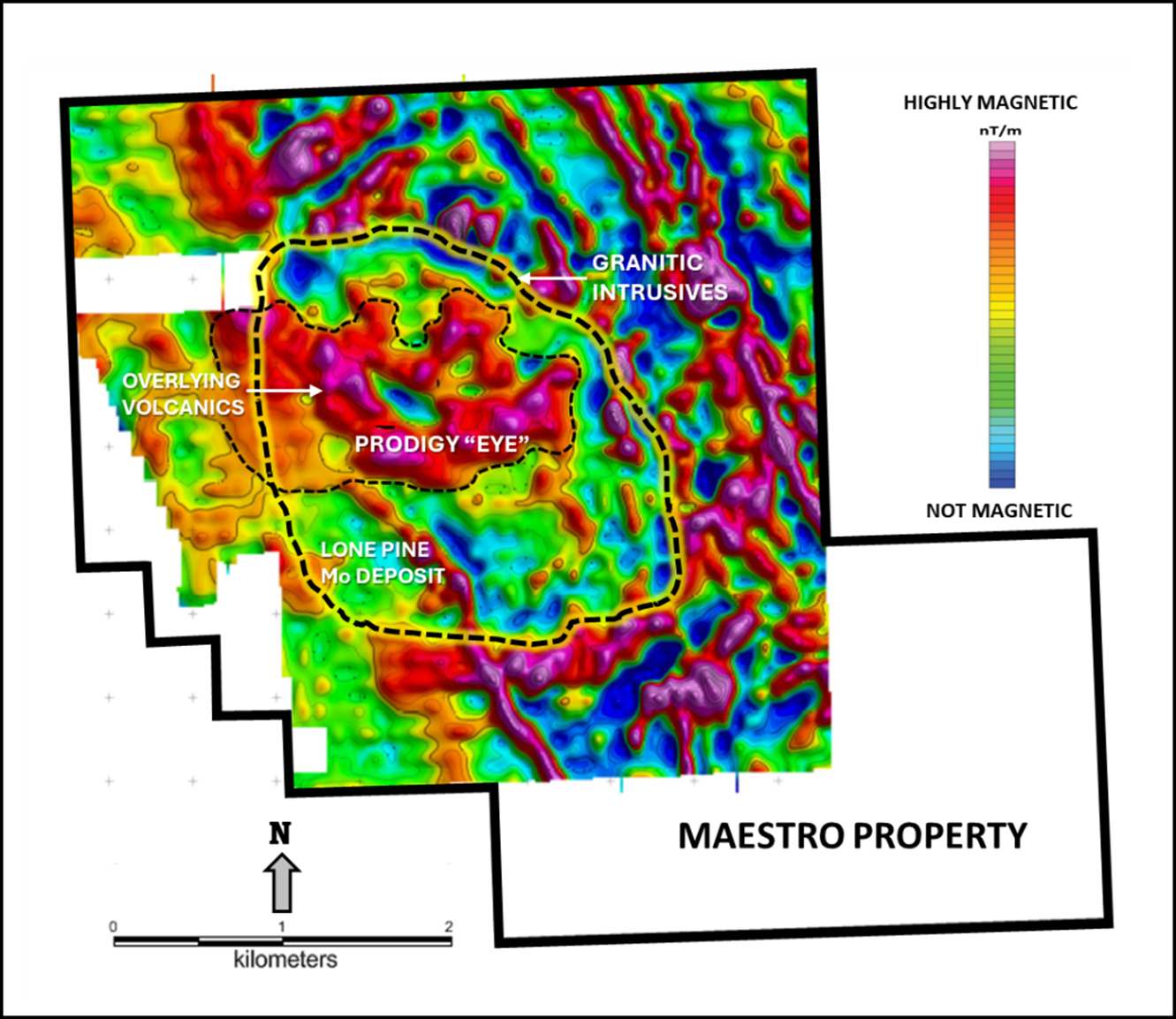
Three distinct types of mineralization have been intersected at Prodigy (See Figures 2, 3, 4, 5, 6, 7 and 8).
Porphyry Au Mineralization
An intrusive body (quartz monzonite) at depth, along with the surrounding volcanic rocks (andesite) host a distinct style of mineralization characterized by pervasive green sericite alteration enriched in gold. Much of the gold mineralization is associated with pyrite rich zones, either as disseminated mineralization or massive, vein-type pyrite. The disseminated pyrite and pyriterich zones within and around the quartz monzonite are classified as Porphyry Au mineralization.
Porphyry Mo-Cu (Mo dominant) and Cu-Mo (Cu dominant) Mineralization
The quartz monzonite and the overlying volcanic rocks are affected by strong K-feldspar and biotite alteration, respectively. Both host rocks are cut by quartz Mo-Cu veins. This early porphyry-type Mo-Cu mineralization has been intersected in several drill holes located on the east and northeast of the "EYE". Notably, drilling has identified increasing Cu grades to the northeast, indicating a potential Porphyry Cu-Mo deposit target located northeast of the Prodigy "EYE" (see Table 5 and Figures 2, 5 and 6). Hole BD-11-70 intersected 151 m grading 0.12% Cu and 0.04% Mo, hole BD-11-68 intersected 107 m grading 0.10% Cu and 0.08% Mo, hole PR25-10 intersected 92 m grading 0.11% Cu and 0.04% Mo, and hole PR25-11 intersected 90 m of 0.16% Cu and 0.04% Mo.
Epithermal Au-Ag-Mo-Cu Mineralization
The early porphyry Mo-Cu mineralization is cut and overprinted by a stockwork of quartz-ankerite veins and vein breccias containing molybdenite, tetrahedrite, chalcopyrite, pyrite, and locally sphalerite and galena assemblages typical of high-to intermediate Au-Ag sulfidation systems developed above porphyry deposits. Breccia bodies occur within the quartz-ankerite vein zone and are associated with intense green sericite alteration. This alteration has destroyed mafic minerals and magnetite, producing the observed low magnetic "EYE" anomaly.
The vein and breccia system hosting the high to intermediate Au-Ag sulfidation mineralization forms an elongated body trending northwest with a funnel shape to depth. Drilling to date has indicated this mineral body is approximately 50-200 m wide, 400 m deep, and 300 m long. It is wide open to the north, south and west.

Figure 2. Prodigy "EYE" Drill Hole Plan Map Showing Drill Hole Traces and AuEQ Estimates. 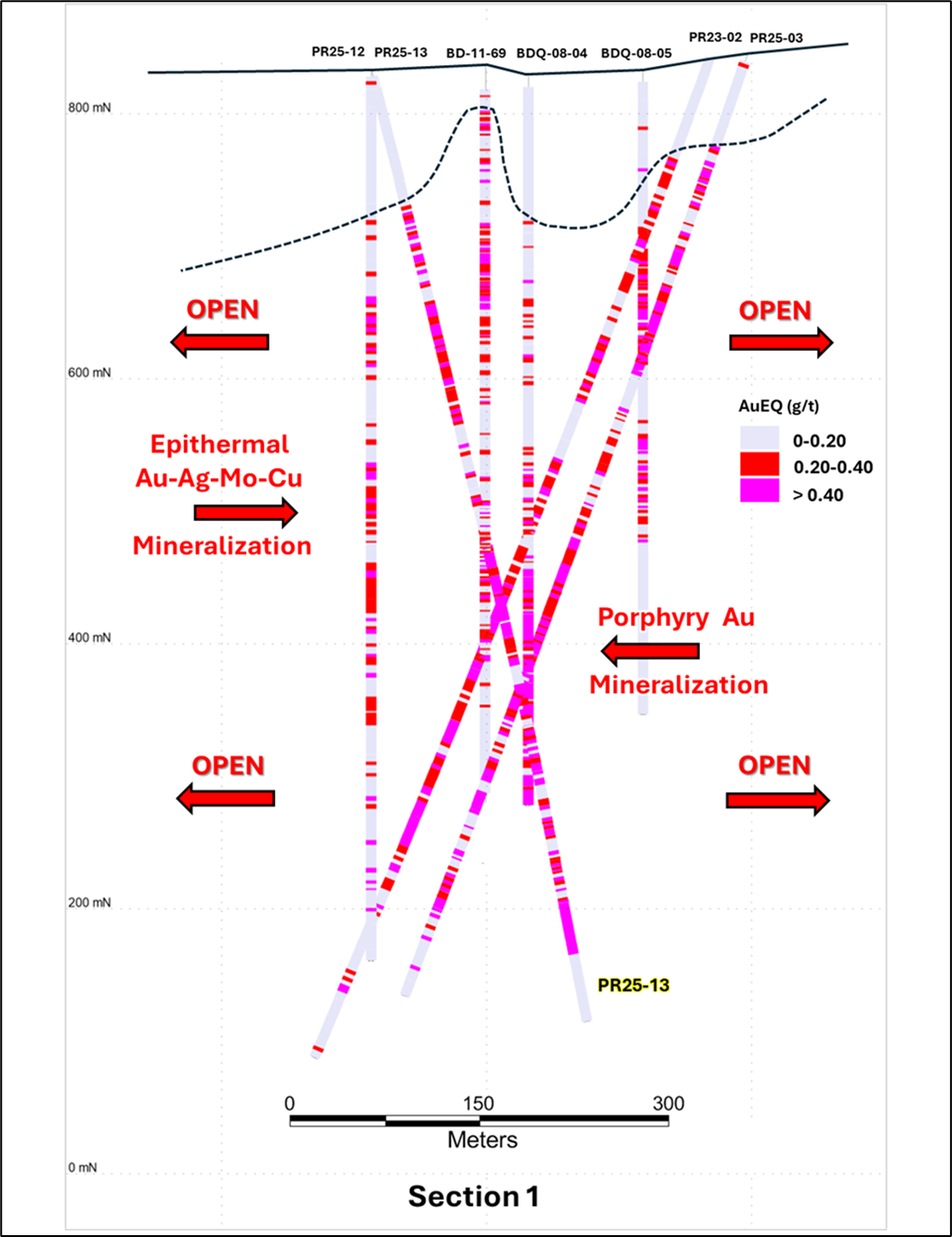
Figure 3. Section 1 Looking Northeasterly - Distribution of AuEQ Estimates. 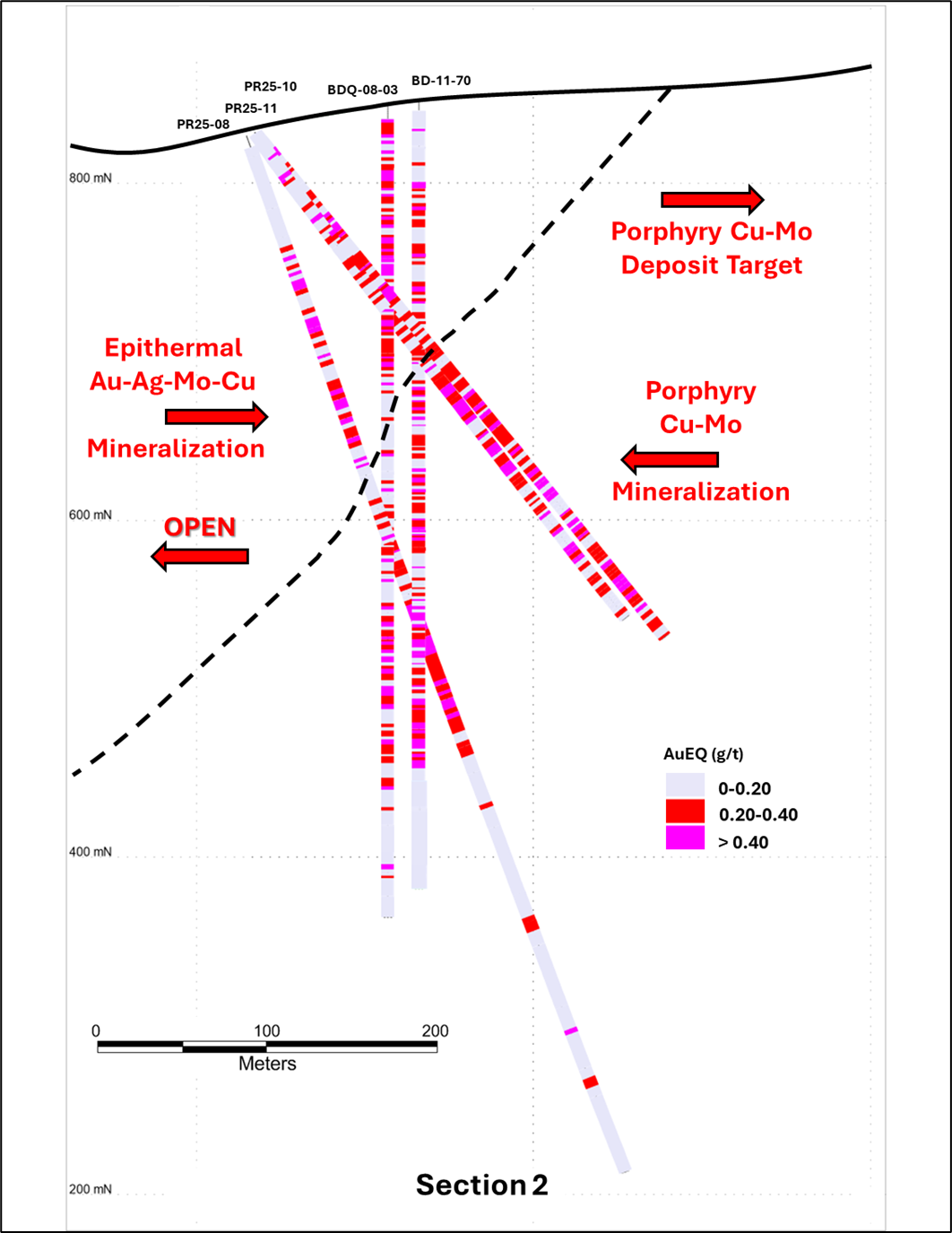
Figure 4. Section 2 Looking Northwesterly - Distribution of AuEQ Estimates. 
Figure 5. Cross Section 2 Looking Northwesterly - Distribution of Cu Mineralization. 
Figure 6. Section 2 Looking Northwesterly - Distribution of Mo Mineralization. Figure 7. Representative Prodigy Rock and Mineral Samples.

PR25-08 at 165 m - Andesite with green sericite alteration cut by high-sulfidation type quartz-ankerite veins with coarse tetrahedrite, pyrite, and chalcopyrite. This sample represents Epithermal Au-Ag mineralization, starting at shallow depths, and grades 0.29 g/t Au and 229 g/t Ag (from a 3 m sample interval).

PR25-03 at 584 m - Quartz monzonite with remnants of pink K-feldspar overprinted by strong pervasivecoarse green sericite alteration with disseminated pyrite and trace tetrahedrite, cut by quartz-ankerite vein with massive coarse pyrite. This sample represents Porphyry Au mineralization and grades 0.64 g/t Au and 84 g/t Ag (from a 2 m sample interval).

PR25-05 at 623 m - Quartz-monzonite with K-silicate alteration, overprinted by green sericite, and cut by quartz-pyrite veins. This sample represents gold-rich porphyry mineralization and grades 0.92 g/t Au and 6 g/t Ag (from a 2.8 m sample interval).
Abbreviations: py=pyrite, cp=chalcopyrite, tet=tetrahedrite, qtz=quartz, ank=ankerite, Kspar=K-feldspar, bio=biotite, ser=sericite.
Figure 8. Core Photos of Au-Rich Porphyry Discovery from Hole PR25-13.
Grades Shown are from 3 m - Sample Intervals.

Age of the Mineralization
A total of four core samples were selected to determine the age of intrusive emplacement and related sulfide mineralization at Prodigy. These include two intrusive rock samples for U-Pb zircon age dating. The U-Pb zircon analyses of the two intrusive samples are currently in progress at the Mineral Deposit Research Unit at the University of British Columbia.
Two samples were also collected for Re-Os molybdenite age dating. One from the early quartz molybdenite-copper veins representing the Porphyry Mo-Cu mineralization stage, and another from a quartz-ankerite-tetrahedrite-molybdenite vein corresponding to the Epithermal Au-Ag-Cu-Mo stage of mineralization. Results from the Re-Os dating completed at the University of Alberta and indicate a Late Cretaceous age for both mineralization stages: 67.75 ± 0.38 Ma for the porphyry Mo-Cu type and 67.08 ± 0.35 Ma for the Au-Ag-Mo-Cu epithermal type mineralization. The overlapping age ranges suggest that the mineralization events were broadly contemporaneous and indicate that Prodigy represents a single, integrated porphyry-to-epithermal Au-Ag system.
The Prodigy system exhibits strong similarities in both mineralization style and alteration assemblages as well as age, to the Blackwater Au-Ag deposit in central British Columbia. The association of Au mineralization with green sericite overprinting earlier biotite alteration at Blackwater closely parallels the Porphyry Au mineralization observed at Prodigy. The main Au mineralization stage at Blackwater, hosted by green sericite alteration, is dated at 65±0.9 Ma (Ar-Ar age: Looby, 2015), which is comparable to the 67.08 ± 0.35 Ma age of the green sericite-hosted Epithermal Au-Ag-Cu-Mo mineralization at Prodigy. However, at Prodigy a clearer transition and genetic link to the underlying gold-rich porphyry center is evident, highlighting its integrated porphyry-epithermal evolutionary continuum.
The Blackwater Gold Mine owned by Artemis Gold Inc., was recently permitted and put into production. At Blackwater Mine, the base case cut-off grade within the reasonable prospects of an eventual economic extraction conceptual pit is 0.20 g/t Au EQ. The Blackwater Base Case Mineral Resource Estimate at a 0.20 g/t AuEQ cut-off on May 5, 2020 was 597 million tonnes grading 0.61 g/t Au and 6.4 g/t Ag (0.65 g/t AuEQ)A,B:
Bird, S, et al (2024) Blackwater Gold Mine, British Columbia, NI 43-101 Technical Report on 2024 Expansion Study prepared for: Artemis Gold Inc., effective date: 21 February, 2024 available at https://www.artemisgoldinc.com/blackwater-project/blackwater-gold-project/technical-reports/ . The Mineral Resource has been confined by a conceptual pit shell to meet "reasonable prospects
of eventual economic extraction" using the following assumptions: the 143% price case with a Base Case of US$1,400/oz Au and US$15/oz Ag at a currency exchange rate of 0.75 US$ per C$; 99.9% payable Au; 95.0% payable Ag; US$8.50/oz Au and US$0.25/oz Ag offsite costs (refining, transport, and insurance); a 1.5% NSR royalty; and uses a 93% metallurgical recovery for gold and 55% recovery for silver. The AuEq values were calculated using US$1,400/oz Au, US$15/oz Ag, a gold metallurgical recovery of 93%, silver metallurgical recovery of 55%, and mining smelter terms for the following equation: AuEq = Au g/t + (Ag g/t x 0.006).
The Qualified Person has been unable to verify this Resource Estimate, and this information is not necessarily indicative of mineralization on the Maestro Property.
TABLE 3

TABLE 4
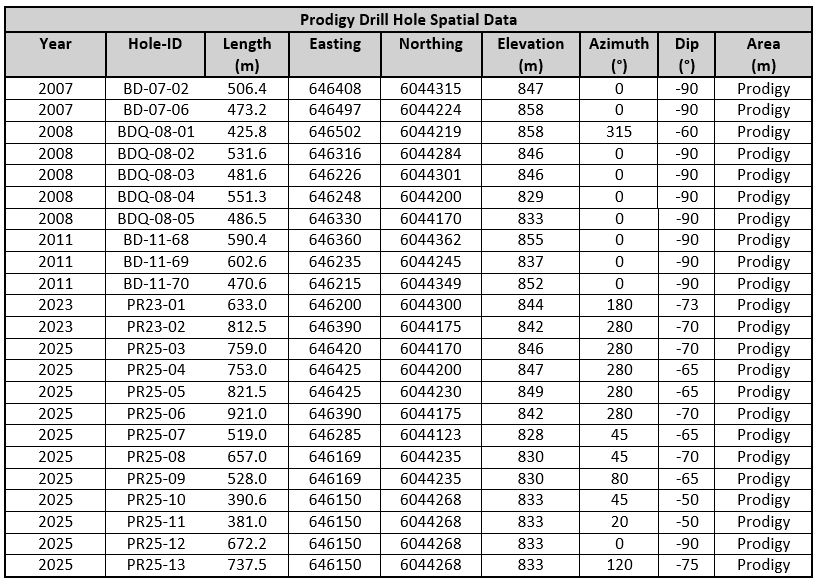
TABLE 5
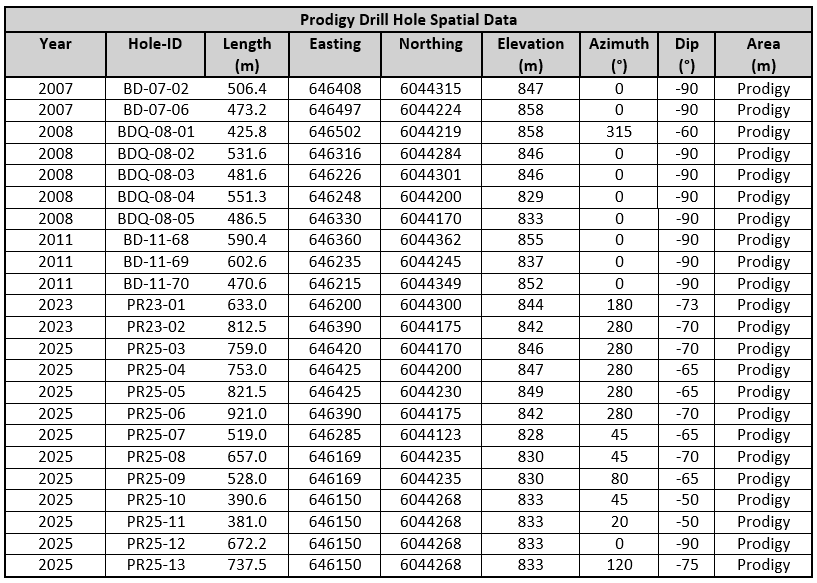
Footnotes to Tables 1, 2, 3, 4 and 5.
Width reported are drill widths, such that true thicknesses are unknown.
All assay intervals represent length-weighted averages.
Some figures may not sum exactly due to rounding.
Gold equivalent (AuEQ) calculations use metal prices of: Au US$1,800.00/oz, Ag US$22.00/oz, Mo US$17.00/lb and Cu US$4.00/lb. and conceptual recoveries of: Au 80%, Ag 80%, Mo 75%, and Cu 75%. Conversion of metals to an equivalent gold grade based on these metal prices is relative to the gold price per unit mass factored by conceptual recoveries for those metals normalized to the conceptualized gold recovery. The metal equivalencies for each metal are added to the gold grade. The general formula is: AuEQ g/t NMV = (Au g/t) + ((Ag recovery / Au recovery) * (Ag $ per oz. / Au $ per oz. * Ag g/t)) + ((Mo recovery / Au recovery) * (Mo % * Mo $ per lb. * 22.0462) / (Au $ per oz. / 31.10348)) + ((Cu recovery / Au recovery) * (Cu % * Cu $ per lb. * 22.0462) / (Au $ per oz. / 31.10348)).
About Quartz
Headquartered in Vancouver, Canada, Quartz Mountain Resources (TSXV:QZM, OTC Pink: QZMRF) is a well- funded public company whose successful mine-finding management team is focused on discovering and transacting important-scale gold, silver and copper projects in British Columbia. The Company owns 100% of the Maestro gold-silver project and 100% of the Jake porphyry copper-gold-silver project. Both projects are permitted by the British Columbia government for drilling activities with access to infrastructure and high potential for the development of substantial resources for significant future transactions.
Quartz is associated with Hunter Dickinson Inc. (HDI), a company with over 35 years of successfully discovering, developing and transacting mineral projects in Canada and internationally. Former HDI projects in British Columbia included Mount Milligan, Kemess South and Gibraltar all of which are porphyry-copper±gold deposits that are currently producing or formerly producing mines. Recently, Amarc Resources, an HDI associate, with funding from Freeport, announced the exciting discovery of the high grade, AuRORA gold-copper-porphyry deposit also in British Columbia. Other wellknown projects with HDI involvement include Sisson, Duke and Prosperity in Canada, Pebble and Florence in the United States, and Xietongmen in China.
Quartz is committed to the advancement of important scale, critical and essential mining assets while following responsible mineral development principles, including a mandate to employ best-practice approaches in the engagement and involvement of local communities and meeting rigorous environmental standards.
About Maestro
The MaestroProject, located in central British Columbia, lies adjacent to Highway 16, 15 km north of Houston and 45 km south of Smithers, providing year-round road access to the Project and nearby infrastructure including, rail, hydroelectricity, and natural gas. This logistical advantage, near resource supporting centres, positions the Maestro Project favourably for potential development. Covering 2,309 hectares, it has a rich exploration history dating back to 1914, primarily focusing on the Lone Pine Mo-Cu porphyry deposit and not the precious metals potential of the surrounding area (see Quartz news release March 19, 2024, and NI 43-101 Technical Report and Preliminary Economic Assessment, P&E Mining Consultants Inc., January 21, 2011).
Since acquiring the property, Quartz has conducted comprehensive geochemical and geophysical surveys, including soil/silt sampling, induced polarization geophysics, airborne magnetic surveys, hyperspectral studies, detailed relogging of historical drill core and assaying for gold only, 976 pulp samples derived from historical assaying of numerous core holes located across the Maestro Property. Quartz's first ever drill test, on its Maestro Property, a Phase 1, two-hole drill program at the Prodigy Zone, discovered exciting high-grade Au-Ag lodes and Ag-Au veins which are both hosted within an extensive epithermal Au-Ag system. The Au lodes and Ag veins along with the more disseminated precious metals intersected by the drill holes are all hosted within a large and earlier deposited, Mo-Cu porphyry system. Quartz's second core hole, PR-23-02 intersected 102 m grading 2.22 g/t Au and 104 g/t Ag, including 12 m grading 1.23 g/t Au and 586 g/t Ag and also 36 m of 5.73 g/t Au and 87 g/t Ag. These results indicate high potential for both bulk tonnage and underground high-grade gold and silver mineralization. Phase 2 and Phase 3 delineation-type drilling of the new Prodigy discovery at Maestro was completed in August, 2025. This staged drilling is outlining a unique gold-rich porphyry system that is closely integrated with Epithermal Au-Ag and Porphyry Cu-Mo mineral systems. It is expected that drilling at Maestro will be consistently advanced with multiple drill program stages going forward. Mineralization remains open, promising significant further potential and multiple other deposit targets exist to be considered.
About Jake
The 100% owned Jake Property is located 160 km north of Smithers in north central BC. It is accessible by helicopter and close to the Minaret airstrip and historical logging roads which lead to mining support towns of Smithers, Fort St. James and Hazelton.
Mineralization at Jake is situated within a prominent rusty coloured gossan measuring 3.5 km long by 1.5 km wide. The combination of extensive historical and recent exploration work has outlined a very expansive altered area at Jake hosting epithermal and porphyry-style sulphide disseminations and veinlets containing Cu-Au-Ag-Zn-Mo and Re. A series of modern surface exploration programs were first completed by Quartz to build on very compelling historical data on the Property developed by legendary porphyry copper explorers, including Kennco, Canadian Superior, Cities Service, Placer Development and Teck Corp. Taken together this comprehensive technical database defined a significant-scale porphyry Cu-Au deposit target which Quartz tested with 3,418 meters of drilling in seven holes during 2024. This drill program successfully discovered a new porphyry Cu-Au-Ag system, wide open to expansion. Upon discovery, Quartz acquired a 100% interest in mineral tenures over an entire new BC porphyry Cu-Au district surrounding the Jake Property. The next milestone towards a transaction will be delineation drilling of the new Jake discovery, currently being planned to commence after substantially advancing delineation drilling at Maestro.
Quality Assurance/Quality Control Program
Quartz drilled NQ size core in the 2023 and 2025 drilling programs. All drill core was logged, photographed, and cut in half with a diamond saw. Half core samples from the 2023 Prodigy drilling were sent to ALS Canada Ltd., Langley, B.C., for preparation and for 2025, half core samples were sent to ALS Canada Ltd., Kamloops, B.C. All samples were analyzed at ALS Canada Ltd., North Vancouver, B.C. All are ISO/IEC 17025:2017 accredited facilities. At the laboratory, samples were dried, crushed to 70% passing -2mm, and a 250 g split pulverized to better than 85% passing 75 microns. Samples were analyzed for Au by fire assay fusion of a 30 g sub-sample with an ICP-AES or AAS finish, and for 46 or 60 elements including Cu, Mo and Ag by a four-acid digestion, multi-element ICP-MS package. Overlimits for Ag, Cu, Pb, and Zn were analyzed four-acid digestion with ICP-AES finish. As part of a comprehensive Quality Assurance/Quality Control ("QAQC") program, Quartz control samples were inserted in each analytical batch at the following rates: standards one in 20 regular samples, in-line replicates one in 20 regular samples and one coarse blank per hole. The control sample results were checked to ensure proper QAQC.
Qualified Person
Farshad Shirmohammad, M.Sc., P. Geo., a "Qualified Person" within the meaning of National Instrument 43-101 - Standards of Disclosure for Minerals Projects, who is not independent of Quartz Mountain Resources Ltd., has reviewed and approved the scientific and technical information contained in this news release.
On behalf of the Board of Directors
Robert Dickinson
Chairman
For further information, please contact:
Bob Dickinson
Email: robertdickinson@hdimining.com Ph: +1 604-684-6365
or:
Roger Blair
Email: rblair@acuityadvisorycorp.com Ph: +1 604-351-0025
or
Jeff Wilson
E Mail: jwilson@acuityadvisorycorp.com Ph: +1 604-837-5440
TABLE 6
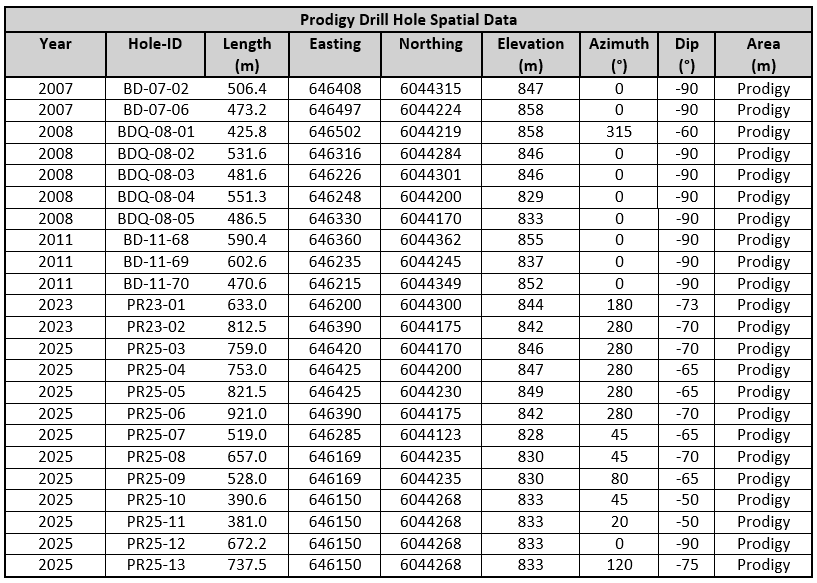
Neither the TSX Venture Exchange nor its Regulation Services Provider (as that term is defined in the policies of the TSX Venture Exchange) accepts responsibility for the adequacy or accuracy of this release.
Cautionary Statement Regarding Forward-Looking Information.
This release includes certain statements that may be deemed "forward-looking-statements". All statements in this release, other than statements of historical facts are forward-looking-statements. Although the Company believes the expectations expressed in such forward-looking statements are based on reasonable assumptions, such statements are not guarantees of future performance and actual results or developments may differ materially from those in the forward-looking statements. Assumptions used by the Company to develop forward-looking statements include the following: the Company's projects will obtain all required environmental and other permits, and all land use and other licenses, studies and exploration of the Company's projects will continue to be positive, and no geological or technical problems will occur. Though the Company believes the expectations expressed in its forward-looking-statements are based on reasonable assumptions, such statements are subject to future events and third party discretion such as regulatory personnel. Factors that could cause actual results to differ materially from those in forward-looking statements include variations in market prices, continuity of mineralization and exploration success, and potential environmental issues or liabilities associated with exploration, development and mining activities, uncertainties related to the ability to obtain necessary permits, licenses and tenure and delays due to third party opposition, changes in and the effect of government policies regarding mining and natural resource exploration and exploitation, and exploration and development of properties located within Aboriginal groups asserted territories that may affect or be perceived to affect asserted aboriginal rights and title, and which may cause permitting delays or opposition by Aboriginal groups, continued availability of capital and financing, and general economic, market or business conditions. Investors are cautioned that any such statements are not guarantees of future performance and actual results or developments may differ materially from those projected in the forward-looking statements. For more information on the Company, and the risks and uncertainties connected with its business, investors should review the Company's home jurisdiction filings as www.sedarplus.ca and its 20F filings with the United States Securities and Exchange Commission.
SOURCE: Quartz Mountain Resources Ltd.
View the original press release on ACCESS Newswire:
https://www.accessnewswire.com/newsroom/en/metals-and-mining/quartz-drilling-intersects-123-m-of-0.79-g%2ft-aueq-and-315-m-of-0.73-g%2ft-aueq-disc-1095900
